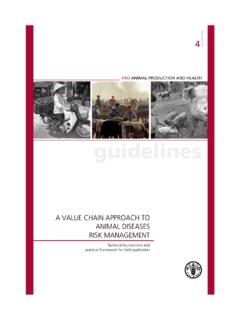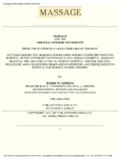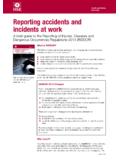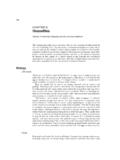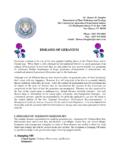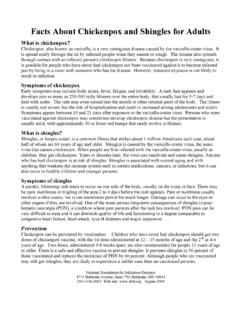Transcription of DEPARTMENT OF LICENSING AND REGULATORY …
1 1 MIOSHA-STD-1209 (10/15) 14 Pages For further information Ph: 517-284-7740 DEPARTMENT OF LICENSING AND REGULATORY AFFAIRS DIRECTOR S OFFICE OCCUPATIONAL HEALTH STANDARDS Filed with the Secretary of State on June 30, 1993 (as amended November 14, 1996) (as amended June 28, 2001) (as amended October 28, 2014) These rules become effective immediately upon filing with the Secretary of State unless adopted under section 33, 44, or 45a(6) of 1969 PA 306. Rules adopted under these sections become effective 7 days after filing with the Secretary of State. (By authority conferred on the director of the DEPARTMENT of LICENSING and REGULATORY affairs by sections 14 and 24 of 1974 PA 154, MCL and , and Executive Reorganization Order Nos. 1996-1 and 1996-2, 2003-1, 2008-4, and 2011-4, MCL , , , and ) R , R , R , R , R , R , R , R , R , R , R and R of the Michigan Administrative code are amended, and R is added, and R and R of the Code are rescinded as follows: PART 554.
2 BLOODBORNE INFECTIOUS DISEASES Table of Contents: R Scope.. 1 R Referenced standards.. 1 R Definitions.. 1 R Exposure determination.. 3 R Exposure control plan.. 3 R Universal precautions.. 4 R Engineering controls.. 4 R Work practices.. 4 R Protective work clothing and equipment.. 5 R Housekeeping.. 5 R Regulated waste disposal.. 6 R Laundry.. 6 R HIV and HBV research laboratories and production 7 R Vaccinations and postexposure follow-up.. 8 R Communication of hazards to employees.. 9 R Recordkeeping.. 10 R Information and training.. 11 Appendix A - Information sheet .. 12 Appendix B - Sample waiver statement when an employee declines the hepatitis b vaccination .. 14 R Scope. Rule 1.
3 These rules apply to all employers that have employees with occupational exposure to blood and other potentially infectious material. R Referenced standards. Rule 1a. (1) The following Michigan occupational safety and health standards are referenced in these rules. Up to 5 copies of these standards may be obtained at no charge from the Michigan DEPARTMENT of LICENSING and REGULATORY Affairs, MIOSHA REGULATORY Services Section, 7150 Harris Drive, Box 30643, Lansing, Michigan 48909-8143, or via the internet at website: For quantities greater than 5, the cost, at the time of adoption of these rules, is 4 cents per page. (a) Occupational Health Standard Part 470 Employee Medical Records and Trade Secrets, R to R (b) MIOSHA Standard Part 11.
4 Recording and Reporting of Occupational Injuries and Illnesses, R to R (2) The appendices to these rules are informational only and are not intended to create any additional obligations or requirements not otherwise imposed by these rules or to detract from any established obligations or requirements. R Definitions. Rule 2. As used in these rules: (a) Act means Michigan occupational safety and health act (MIOSHA), 1974 PA 154, MCL to 2 (b) Biologically hazardous conditions means equipment, containers, rooms, materials, experimental animals, animals infected with HBV or HIV virus, or combinations thereof that contain, or are contaminated with, blood or other potentially infectious material.
5 (c) Blood means human blood, human blood components, and products made from human blood. (d) Bloodborne pathogens means pathogenic microorganisms that are present in human blood and can cause disease in humans. These pathogens include hepatitis B virus (HBV) and human immunodeficiency virus (HIV). (e) Clinical laboratory means a workplace where diagnostic or other screening procedures are performed on blood or other potentially infectious material. (f) Contaminated means the presence or the reasonably anticipated presence of blood or other potentially infectious material on an item or surface. (g) Contaminated laundry means laundry that has been soiled with blood or other potentially infectious materials or that may contain sharps.
6 (h) Contaminated sharps means any contaminated object that can penetrate the skin, including any of the following: (i) Needles. (ii) Scalpels. (iii) Broken glass. (iv) Broken capillary tubes. (v) Exposed ends of dental wires. (i) Decontamination means the use of physical or chemical means to remove, inactivate, or destroy bloodborne pathogens on a surface or item to the point where they are no longer capable of transmitting infectious particles and the surface or item is rendered safe for handling, use, or disposal. (j) DEPARTMENT means the DEPARTMENT of LICENSING and REGULATORY affairs. (k) Director means the director of the DEPARTMENT or his or her designee. (l) Disinfect means to inactivate virtually all recognized pathogenic microorganisms, but not necessarily all microbial forms, on inanimate objects.
7 (m) Engineering controls means controls, for example, sharps disposal containers, self-sheathing needles, or safer medical devices, such as sharps with engineered sharps injury protections and needleless systems, that isolate or remove the bloodborne pathogen hazard from the workplace. (n) Exposure means reasonably anticipated skin, eye, mucous membrane, or parenteral contact with blood or other potentially infectious materials that may result from the performance of an employee s duties. Exposure does not include incidental exposures that may take place on the job, that are neither reasonably nor routinely expected, and that the worker is not required to incur in the normal course of employment.
8 (o) Exposure incident means a specific eye, mouth, other mucous membrane, nonintact skin, or parenteral contact with blood or other potentially infectious material that results from the performance of an employee s duties. (p) Handwashing facilities means facilities that provide an adequate supply of running, potable water, soap, and single-use towels or an air drying machine. (q) Licensed health care professional means a person whose legally permitted scope of practice allows him or her to independently perform the activities required by R concerning hepatitis B vaccination and post-exposure evaluation and follow-up. (r) Needleless systems means a device that does not use needles for any of the following: (i) The collection of bodily fluids or withdrawal of body fluids after initial venous or arterial access is established.
9 (ii) The administration of medication or fluids. (iii) Any other procedure involving the potential for occupational exposure to bloodborne pathogens due to percutaneous injuries from contaminated sharps. (s) Other potentially infectious material means any of the following: (i) Any of the following human body fluids: (A) Semen. (B) Vaginal secretions. (C) Amniotic fluid. (D) Cerebrospinal fluid. (E) Peritoneal fluid. (F) Pleural fluid. (G) Pericardial fluid. (H) Synovial fluid. (I) Saliva in dental procedures. (J) Any body fluid that is visibly contaminated with blood. (K) All body fluids in situations where it is difficult or impossible to differentiate between body fluids. (ii) Any unfixed tissue or organ, other than intact skin, from a living or dead human.
10 (iii) Cell or tissue cultures that contain HIV, organ cultures, and culture medium or other solutions that contain HIV or HBV; and blood, organs, or other tissues from experimental animals infected with HIV or HBV. (t) Parenteral means exposure occurring as a result of piercing mucous membrane or the skin barrier, such as exposure through subcutaneous, intramuscular, intravenous, or arterial routes resulting from needlesticks, human bites, cuts, and abrasions. (u) Personal protective equipment or PPE means specialized clothing or equipment that is worn by an employee to protect him or her from a hazard. General work clothes, such as uniforms, pants, shirts, or blouses, that are not intended to function as protection against a hazard are not considered to be personal protective equipment.











